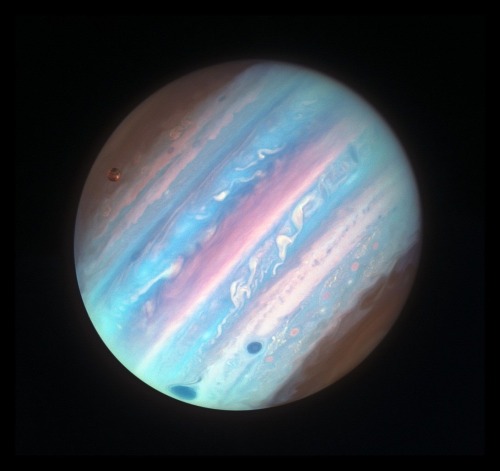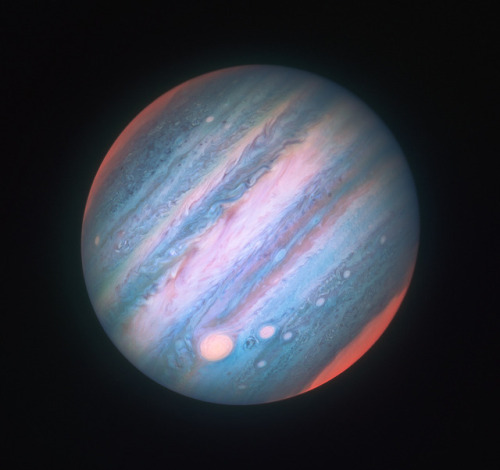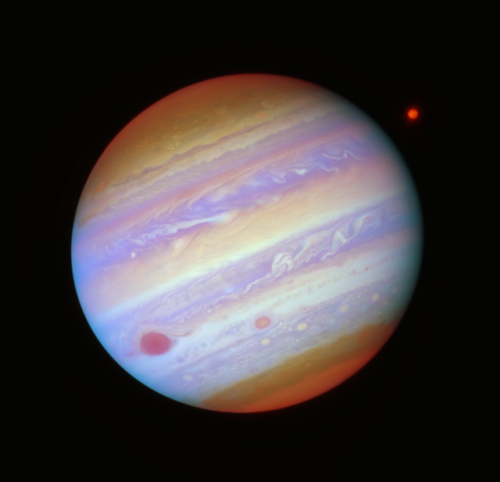A Tour Of Storms Across The Solar System
A Tour of Storms Across the Solar System

Earth is a dynamic and stormy planet with everything from brief, rumbling thunderstorms to enormous, raging hurricanes, which are some of the most powerful and destructive storms on our world. But other planets also have storm clouds, lightning — even rain, of sorts. Let’s take a tour of some of the unusual storms in our solar system and beyond.
Tune in May 22 at 3 p.m. for more solar system forecasting with NASA Chief Scientist Jim Green during the latest installment of NASA Science Live: https://www.nasa.gov/nasasciencelive.

1. At Mercury: A Chance of Morning Micrometeoroid Showers and Magnetic ‘Tornadoes’
Mercury, the planet nearest the Sun, is scorching hot, with daytime temperatures of more than 800 degrees Fahrenheit (about 450 degrees Celsius). It also has weak gravity — only about 38% of Earth’s — making it hard for Mercury to hold on to an atmosphere.
Its barely there atmosphere means Mercury doesn’t have dramatic storms, but it does have a strange “weather” pattern of sorts: it’s blasted with micrometeoroids, or tiny dust particles, usually in the morning. It also has magnetic “tornadoes” — twisted bundles of magnetic fields that connect the planet’s magnetic field to space.

2. At Venus: Earth’s ‘Almost’ Twin is a Hot Mess
Venus is often called Earth’s twin because the two planets are similar in size and structure. But Venus is the hottest planet in our solar system, roasting at more than 800 degrees Fahrenheit (430 degrees Celsius) under a suffocating blanket of sulfuric acid clouds and a crushing atmosphere. Add to that the fact that Venus has lightning, maybe even more than Earth.
In visible light, Venus appears bright yellowish-white because of its clouds. Earlier this year, Japanese researchers found a giant streak-like structure in the clouds based on observations by the Akatsuki spacecraft orbiting Venus.

3. At Earth: Multiple Storm Hazards Likely
Earth has lots of storms, including thunderstorms, blizzards and tornadoes. Tornadoes can pack winds over 300 miles per hour (480 kilometers per hour) and can cause intense localized damage.
But no storms match hurricanes in size and scale of devastation. Hurricanes, also called typhoons or cyclones, can last for days and have strong winds extending outward for 675 miles (1,100 kilometers). They can annihilate coastal areas and cause damage far inland.

4. At Mars: Hazy with a Chance of Dust Storms
Mars is infamous for intense dust storms, including some that grow to encircle the planet. In 2018, a global dust storm blanketed NASA’s record-setting Opportunity rover, ending the mission after 15 years on the surface.
Mars has a thin atmosphere of mostly carbon dioxide. To the human eye, the sky would appear hazy and reddish or butterscotch colored because of all the dust suspended in the air.

5. At Jupiter: A Shrinking Icon
It’s one of the best-known storms in the solar system: Jupiter’s Great Red Spot. It’s raged for at least 300 years and was once big enough to swallow Earth with room to spare. But it’s been shrinking for a century and a half. Nobody knows for sure, but it’s possible the Great Red Spot could eventually disappear.

6. At Saturn: A Storm Chasers Paradise
Saturn has one of the most extraordinary atmospheric features in the solar system: a hexagon-shaped cloud pattern at its north pole. The hexagon is a six-sided jet stream with 200-mile-per-hour winds (about 322 kilometers per hour). Each side is a bit wider than Earth and multiple Earths could fit inside. In the middle of the hexagon is what looks like a cosmic belly button, but it’s actually a huge vortex that looks like a hurricane.
Storm chasers would have a field day on Saturn. Part of the southern hemisphere was dubbed “Storm Alley” by scientists on NASA’s Cassini mission because of the frequent storm activity the spacecraft observed there.

7. At Titan: Methane Rain and Dust Storms
Earth isn’t the only world in our solar system with bodies of liquid on its surface. Saturn’s moon Titan has rivers, lakes and large seas. It’s the only other world with a cycle of liquids like Earth’s water cycle, with rain falling from clouds, flowing across the surface, filling lakes and seas and evaporating back into the sky. But on Titan, the rain, rivers and seas are made of methane instead of water.
Data from the Cassini spacecraft also revealed what appear to be giant dust storms in Titan’s equatorial regions, making Titan the third solar system body, in addition to Earth and Mars, where dust storms have been observed.

8. At Uranus: A Polar Storm
Scientists were trying to solve a puzzle about clouds on the ice giant planet: What were they made of? When Voyager 2 flew by in 1986, it spotted few clouds. (This was due in part to the thick haze that envelops the planet, as well as Voyager’s cameras not being designed to peer through the haze in infrared light.) But in 2018, NASA’s Hubble Space Telescope snapped an image showing a vast, bright, stormy cloud cap across the north pole of Uranus.

9. At Neptune: Methane Clouds
Neptune is our solar system’s windiest world. Winds whip clouds of frozen methane across the ice giant planet at speeds of more than 1,200 miles per hour (2,000 kilometers per hour) — about nine times faster than winds on Earth.
Neptune also has huge storm systems. In 1989, NASA’s Voyager 2 spotted two giant storms on Neptune as the spacecraft zipped by the planet. Scientists named the storms “The Great Dark Spot” and “Dark Spot 2.”

10. It’s Not Just Us: Extreme Weather in Another Solar System
Scientists using NASA’s Hubble Space Telescope made a global map of the glow from a turbulent planet outside our solar system. The observations show the exoplanet, called WASP-43b, is a world of extremes. It has winds that howl at the speed of sound, from a 3,000-degree-Fahrenheit (1,600-degree-Celsius) day side, to a pitch-black night side where temperatures plunge below 1,000 degrees Fahrenheit (500 degrees Celsius).
Discovered in 2011, WASP-43b is located 260 light-years away. The planet is too distant to be photographed, but astronomers detected it by observing dips in the light of its parent star as the planet passes in front of it.
Make sure to follow us on Tumblr for your regular dose of space: http://nasa.tumblr.com.
More Posts from Blacktealattee and Others









Jupiter (filtered) by Judith Schmidt.

Sol Lewitt







Bring on the sass baby! Gerard is owning the stage during Zero Fest in Mexico City on April 12, 2008.
[photo credit; toni francois]
Solar System: 10 Things to Know This Week
Week of March 5: Great Shots Inspiring views of our solar system and beyond
1-Mars-By-Numbers

“The first TV image of Mars, hand colored strip-by-strip, from Mariner 4 in 1965. The completed image was framed and presented to JPL director, William H. Pickering. Truly a labor of love for science!” -Kristen Erickson, NASA Science Engagement and Partnerships Director
2-Night Life

“There are so many stories to this image. It is a global image, but relates to an individual in one glance. There are stories on social, economic, population, energy, pollution, human migration, technology meets science, enable global information, etc., that we can all communicate with similar interests under one image.” -Winnie Humberson, NASA Earth Science Outreach Manager
3-Pale Blue Dot

“Whenever I see this picture, I wonder…if another species saw this blue dot what would they say and would they want to discover what goes on there…which is both good and bad. However, it would not make a difference within the eternity of space—we’re so insignificant…in essence just dust in the galactic wind—one day gone forever.”
-Dwayne Brown, NASA Senior Communications Official
4-Grand Central

“I observed the Galactic Center with several X-ray telescopes before Chandra, including the Einstein Observatory and ROSAT. But the Chandra image looks nothing like those earlier images, and it reminded me how complex the universe really is. Also I love the colors.” -Paul Hertz, Director, NASA Astrophysics Division
5-Far Side Photobomb

“This image from the Deep Space Climate Observatory (DSCOVR) satellite captured a unique view of the Moon as it moved in front of the sunlit side of Earth in 2015. It shows a view of the farside of the Moon, which faces the Sun, that is never directly visible to us here on Earth. I found this perspective profoundly moving and only through our satellite views could this have been shared.” -Michael Freilich, Director NASA Earth Science Division
6-”Shocking, Exciting and Wonderful”

“Pluto was so unlike anything I could imagine based on my knowledge of the Solar System. It showed me how much about the outer solar system we didn’t know. Truly shocking, exciting and wonderful all at the same time.” -Jim Green, Director, NASA Planetary Science Division
7-Slices of the Sun

“This is an awesome image of the Sun through the Solar Dynamic Observatory’s many filters. It is one of my favorites.” - Peg Luce, Director, NASA Heliophysics Division (Acting)
8-Pluto’s Cold, Cold Heart

“This high-resolution, false color image of Pluto is my favorite. The New Horizons flyby of Pluto on July 14, 2015 capped humanity’s initial reconnaissance of every major body in the solar system. To think that all of this happened within our lifetime! It’s a reminder of how privileged we are to be alive and working at NASA during this historic era of space exploration.” - Laurie Cantillo, NASA Planetary Science Public Affairs Officer
9-Family Portrait

“The Solar System family portrait, because it is a symbol what NASA exploration is really about: Seeing our world in a new and bigger way.” - Thomas H. Zurbuchen, Associate Administrator, NASA Science Mission Directorate
10-Share Your Favorite Space Shots

Tag @NASASolarSystem on your favorite social media platform with a link to your favorite image and few words about why it makes your heart thump.
Check out the full version of this article HERE.
Make sure to follow us on Tumblr for your regular dose of space: http://nasa.tumblr.com.

Summer Milky Way at Boddington, Western Australia
Nikon d5500 - 50mm - ISO 3200 - f/2.8 - Foreground: 9 x 15 seconds - Sky: 26 x 30 seconds - iOptron SkyTracker - Hoya Red Intensifier filter
-
 somethinggsomething reblogged this · 1 year ago
somethinggsomething reblogged this · 1 year ago -
 ompolitimo liked this · 1 year ago
ompolitimo liked this · 1 year ago -
 unabashedmoonhideout6969 liked this · 1 year ago
unabashedmoonhideout6969 liked this · 1 year ago -
 the-floppa-k1ller liked this · 3 years ago
the-floppa-k1ller liked this · 3 years ago -
 budahbutt reblogged this · 3 years ago
budahbutt reblogged this · 3 years ago -
 off-by-one liked this · 3 years ago
off-by-one liked this · 3 years ago -
 shwahlsweet reblogged this · 3 years ago
shwahlsweet reblogged this · 3 years ago -
 mimundo-arcoiris liked this · 3 years ago
mimundo-arcoiris liked this · 3 years ago -
 sidusglacies reblogged this · 3 years ago
sidusglacies reblogged this · 3 years ago -
 fatmaothman liked this · 3 years ago
fatmaothman liked this · 3 years ago -
 an-abyss-called-life liked this · 3 years ago
an-abyss-called-life liked this · 3 years ago -
 boyist liked this · 3 years ago
boyist liked this · 3 years ago -
 thepurevessel1 liked this · 3 years ago
thepurevessel1 liked this · 3 years ago -
 jokervenny liked this · 3 years ago
jokervenny liked this · 3 years ago -
 deepermadness reblogged this · 3 years ago
deepermadness reblogged this · 3 years ago -
 toastbite liked this · 4 years ago
toastbite liked this · 4 years ago -
 bendaradrylcocosquat liked this · 4 years ago
bendaradrylcocosquat liked this · 4 years ago -
 sirona7 liked this · 4 years ago
sirona7 liked this · 4 years ago -
 nukeli liked this · 4 years ago
nukeli liked this · 4 years ago -
 quartzbabe liked this · 4 years ago
quartzbabe liked this · 4 years ago -
 soleilcentauri liked this · 4 years ago
soleilcentauri liked this · 4 years ago -
 the-ultimate-trashcan liked this · 4 years ago
the-ultimate-trashcan liked this · 4 years ago -
 conjurebaby reblogged this · 4 years ago
conjurebaby reblogged this · 4 years ago -
 conjurebaby liked this · 4 years ago
conjurebaby liked this · 4 years ago -
 lithium6941 reblogged this · 4 years ago
lithium6941 reblogged this · 4 years ago -
 lithium6941 liked this · 4 years ago
lithium6941 liked this · 4 years ago -
 tom-the-tortoise liked this · 4 years ago
tom-the-tortoise liked this · 4 years ago -
 naughtybodypillow liked this · 4 years ago
naughtybodypillow liked this · 4 years ago -
 cyberfairyofchaoticacademia reblogged this · 4 years ago
cyberfairyofchaoticacademia reblogged this · 4 years ago

21 posts






